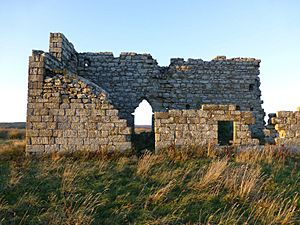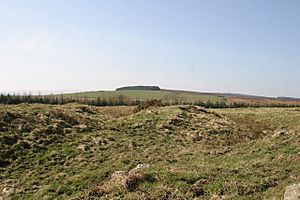Jenny's Lantern facts for kids
Jenny's Lantern is a special place in Northumberland, England. It's a moorland area named after an old building called a 'folly'. This folly was built in the 1700s on a small hill overlooking the River Aln.
On the southern side of Jenny's Lantern, you can find an ancient Iron Age hillfort. Right next to it, there's a much larger and well-preserved settlement from the Romano-British period. This settlement includes stone buildings and old farm fields.
Contents
Where is Jenny's Lantern?
The Jenny's Lantern area is a small hill that faces south. It rises about 144 meters (472 feet) above the River Aln valley, which is about 50 meters (164 feet) high.
It is located about 1.32 miles (2.1 kilometers) northeast of Bolton. It is also about 2.7 miles (4.3 kilometers) south of Eglingham, both villages in north Northumberland.
What's in the Name?
The name Jenny's Lantern comes from an old Northumbrian legend. 'Jenny's Lantern' or 'Jenny of the Lantern' is another name for a Will-o'-the-wisp. This is a mysterious light that people believed would float over bogs or swamps.
The legend says these lights would trick travelers and lead them into dangerous places. One story about this Jenny's Lantern tells of a shepherd. He was following a lantern light he thought was his wife Jenny's. She had lit it to guide him home from the inn at Eglingham. Sadly, he drowned in a bog while following the light.
The Folly: An Old 'Eye-Catcher'
An 18th-century building, known as a folly, stands near the top of Jenny's Lantern. It was likely built by the owners of the nearby Bolton estate. A folly is a building made to look like an old ruin, often just for decoration.
This folly looks like a ruined shepherd's cottage. It has a rectangular shape with a door and windows on its south side. One wall is complete, but the eastern side looks like it's falling apart. Experts think it was an "eye-catcher." This means it was built to be seen from a distance, adding beauty to the landscape.
Some believe its design was inspired by Crawley Tower, a 14th-century tower house about 3.2 miles (5.1 kilometers) away. That tower was also changed in the 1700s to be an eye-catcher. Important landowners like Hugh Percy, 1st Duke of Northumberland also built follies. He had the Ratcheugh Observatory built before 1770. His Brizlee Tower, built in 1781, sits across the River Aln from Jenny's Lantern.
The Iron Age Hillfort
The Jenny's Lantern hillfort is an ancient settlement from the Iron Age. We don't know its exact age, but it fits the style of forts built between about 700 BCE and 100 CE.
This fort is located about 135 meters (443 feet) up the hill. It has two large banks of earth, called ramparts, for defense. The inner rampart is about 0.6 meters (2 feet) high, and the outer one is up to 1.5 meters (5 feet) high. Between them is a ditch about 6 meters (20 feet) wide.
The fort is shaped like an oval, about 100 meters (328 feet) long and 68 meters (223 feet) wide. It has entrances at its northeast and southwest ends.
The Romano-British Settlement
The Jenny's Lantern site is about 2.4 miles (3.9 kilometers) east of the Devil's Causeway. This was a major Roman road running north to south. It's also about 2.6 miles (4.2 kilometers) north-northeast of the Roman fort at Learchild.
The area around the Iron Age hillfort at Jenny's Lantern has the remains of a Romano-British settlement. You can see traces of at least 15 circular stone huts. These huts were about 4 to 6 meters (13 to 20 feet) across. Three huts are inside the old hillfort. The rest are outside in seven fenced areas.
To the south and east of these areas, you can find an old field system. It is marked by lines of rubble and boulders. In 1824, a small glass bottle called a lacrymatory was found here. In 1885, a quern-stone (used for grinding grain) was discovered.
Experts say that the Iron Age fort, the Romano-British settlement, and its field system are excellent examples of their kind. It's rare to find Romano-British field systems still preserved. This makes the Jenny's Lantern site very important for understanding history.
Protecting the Site
The hillfort and settlement at Jenny's Lantern are on the Heritage at Risk Register. This means their condition is not good, and there are some big problems. The main issue is bracken, a type of fern. It grows over the site and can damage the old remains. Efforts are being made to protect this valuable historical place.



